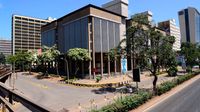
The loan deposit spread fell to 5.5 percent in the year to December 2022 from 5.66 percent in December 2021. By KEPHA MUIRURI
Interest margins from loans have narrowed as commercial banks offer higher returns on fixed deposit accounts to retain funding from major depositors.
Data from the 2023 Economic Survey shows the loan deposit spread fell to 5.5 percent in the year to December 2022 from 5.66 percent in December 2021.
The closing of the interest margins points to an increased cost of funds for commercial banks that traditionally mobilise long-term deposits for the purpose of on-lending.
Large banks nevertheless enjoy lower cost of funds based on their ability to attract significant deposits through the lower interest-bearing current account and savings accounts which are commonly referred to as CASA and make up the cheapest and major source of funds for banks.
Read: Kenyans prefer sacco loans to bank lending
The lower spreads have been achieved off the back of a tighter monetary policy stance by the Central Bank of Kenya (CBK), which raised the benchmark lending rate of the Central Bank Rate (CBR) some three times across 2022 to move the CBR from seven percent in December 2021 to 8.75 percent at the end of last year.
Presently, the CBR stands at 9.50 percent, a five-year high with the CBK having further tightened its monetary stance with the view of taming inflation which remains outside the government sweet spot of 2.5 to 7.5 percent.
The combination of a higher benchmark rate and high inflation has set off a general rise in interest rates which has fired up yields on interest-bearing assets such as Treasury bills, bonds, commercial bank loans and overdrafts.
Commercial banks have had to battle for cash with other interest-bearing assets and raised the average fixed deposit rate to a 52-month high of 7.54 percent at the end of February according to additional data from the CBK.
Analysts have previously tied the increased return on fixed deposit accounts, which are now catching up to hikes in the lending rate to the battle to retain long-term deposits.
“With election-induced uncertainty having melted away and with the benchmark rate having dialled higher, banks had to attract deposits by increasing their fixed deposit rates,” Churchill Ogutu an economist at IC Asset Managers (Mauritius) told the Business Daily last month.
For analysts at Genghis Capital, banks have found the edge in offering a greater return from fixed deposits as the wealthy seek to protect value through hedging over exploring new areas of investing in the volatile interest rate environment.
At present, the spreads between the lending rate and the fixed deposit return stand at 5.52 percent with the lending rate having stood at a near five-year high of 13.06 percent, the highest rate since July 2018.
Read: How Kenyan banks are pricing their loans
The spreads have however risen marginally from a lower 5.3 percent in January.
Rising returns on government debt securities have primarily forced lenders to increase savings rates from large depositors.
→ kmuiruri@ke.nationmedia.com






No comments :
Post a Comment